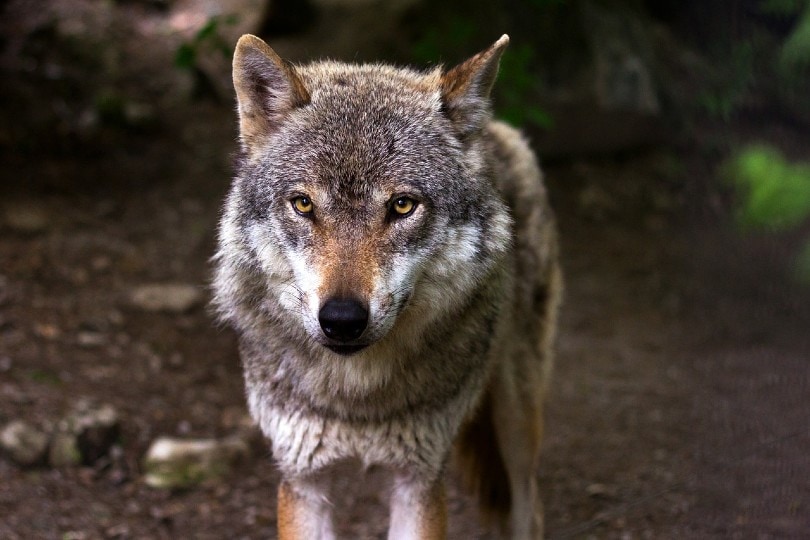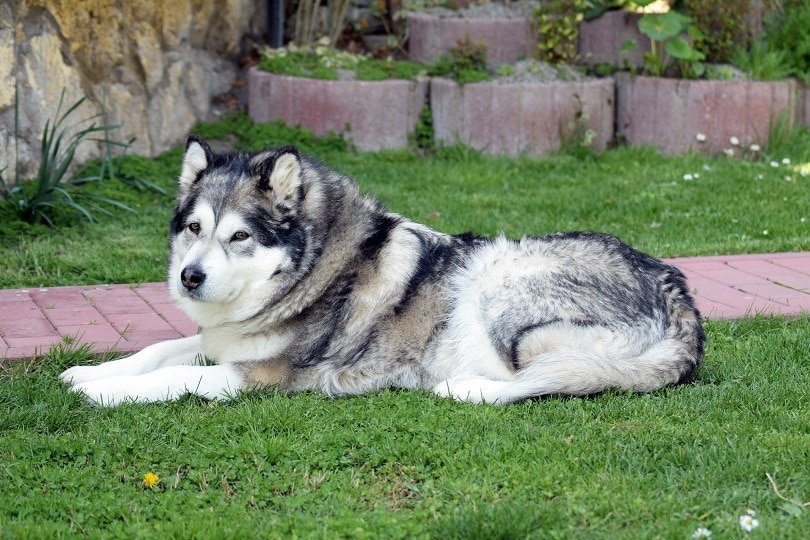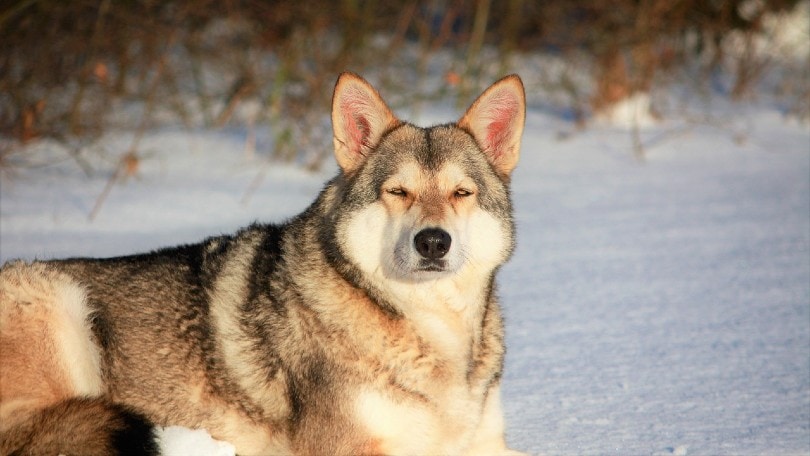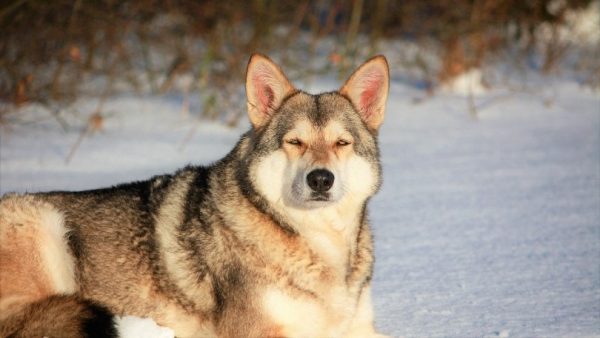Click to Skip Ahead
There’s so much that scientists still don’t know about the true origins of modern dogs and a great deal of conflicting research out there.1 However, there are things we know that are certainly true. For example, it’s true that all dogs come from wolves. In fact, dogs are the earliest known domesticated animals. That said, they probably were domesticated on separate occasions in different parts of the world. Let’s find out more!
From Miacid to Wolf
Wolves, like dogs, have not been around since the beginning of time. We know that the gray wolf was a canine predator in North America starting about 750,000 years ago.2 Before that, though, there were Miacids.
Miacids were carnivores that ranged in size from very small (like a gopher) to the size of dogs as we know them today, and they were around for 52 million years. After that, the feline and canine groups split, and many kinds of wolves emerged 2 or 3 million years ago. The first gray wolf (one type of wolf that we know today) was probably in Eurasia around 1 million years ago.

From Wolf to Dog
The transition from the wolf to the dog is still quite foggy and difficult for scientists to decipher.
Before 2016, it was assumed that all dogs were domesticated from wolves about 15,000 to 40,000 years ago, in either South China, Mongolia, or Siberia. Scientists have not agreed on a specific era or location.
Now, the latest research suggests that modern, domesticated dogs came from two different colonies of wolves on opposite sides of the “Old World,” the part of the world that includes Africa, Asia, and Europe, before the existence of the Americas was known. The research says that the origins of dogs came about independently, from two different locations and at two different times.
The game changed when the Newgrange dog was found in an ancient Irish burial several years ago. The dog was 4,800 years old and had the best-preserved DNA in its bones than ever discovered before. This enabled scientists to look directly into ancient dog DNA along with previous ancient dog DNA samples.
Upon taking this new data and comparing it to others, scientists discovered that the modern dog came from one European area and one East Asian area. At one point in history, there was a decrease in the dog population in Europe. The East Asian dogs were possibly brought in to sustain the species, or the dogs simply were traveling along with their migrating owners.
What probably happened was that there was one population of a now-extinct type of wolf in the ancient world that was split in two (one group went East and one went West), and then they were domesticated separately before they were extinct. After that, the dogs from the East traveled to the West with their humans who migrated there, then they mixed and somewhat replaced the Western dogs.
Not only did domesticated dogs mate with each other, but dogs and wolves have also continued to interbreed since domestication. This fact also distorts the genome of the modern dog, making it difficult to figure out the exact origins.

Dogs Likely Domesticated Themselves
A lot of people think that humans domesticated dogs. But many experts do not agree with this theory. They suggest that dogs domesticated themselves.
It makes sense if you think about life in ancient times. Dogs and humans competed for food, and one could have easily taken down the other. Here’s what may have happened: Docile wolves came to friendly humans for scraps of food or other sustenance or protection. In this way, wolves exploited a human weakness for themselves and got them to bring them out of the cold and provide scraps of food and other kinds of help. Dogs probably came about through “survival of the friendliest” rather than humans winning “survival of the fittest.”
How Did Dogs’ Appearances Change So Much From Wolves?
It’s hard to believe that breeds like Chihuahuas and French Bulldogs evolved from wolves, but it’s still true. Scientists have not yet found any evidence to prove otherwise. But how did this happen?
Brian Hare, director of the Duke University Canine Cognition Center, suggests that the physical changes in dogs occurred because of their friendliness. It’s a process called self-domestication. This theory is proven by a case of fox domestication in Russia. When experimenters bred foxes that were comfortable with human interaction, over time, the more social fox kits displayed more amiable features, i.e., they looked cuter and less vicious to humans.
From there, through the different regions’ domesticated dogs intermingling and intentionally breeding for certain traits, different sizes, shapes, heights, and other physical characteristics came about.

Which Dogs Are Closest to Wolves?
While most dogs look quite distinct from wolves, some dogs still hold close genetic ties. These dogs can either look like wolves, look nothing like wolves but still have close DNA, or have certain personality traits that are wolf-like.
- Lhasa Apso
- Shiba Inu
- Shih Tzu
- Siberian Husky
- Saluki
- Afghan Hound
- Chow Chow
- Pekingese
- Alaskan Malamute

Wolves Have Physical and Pack Smarts; Dogs Have Social Smarts
One interesting thing to note about the evolution from the wolf to the dog is the different bits of intelligence each species has.
A University of Vienna research team wanted to figure this out. They presented dogs and wolves with impossible problems to solve in the shape of puzzles. While the wolves got to work right away with physical force and using trial and error to solve the puzzle, many dogs would look back to their humans for answers and were unable to try anything on their own.
The results of this study tell us this: Domesticated dogs possibly lost the specific genes needed to problem solve and work as a group with other dogs, something that’s still intact in wolves. Instead, dogs have learned to use humans to solve their problems and depend on them heavily. This also makes dogs more responsive to human cues.

- You May Also Like: Wolf vs. Dog
How Dogs Are Still Like Wolves Today
It’s believed that dogs still retain a few wolf characteristics, such as their pack mentality. In one-dog households and with certain breeds of dogs more than others, the dog tends to see their owner as their leader. If the dog deems that the human is not doing their duty, they may act as the leader instead. Multiple-dog households can also have a pack mentality within the group of dogs, but this can change day by day.
Also, dogs sometimes lick to greet the people around them. Wolves do this to their pack members to show affection too!
Final Thoughts
Dogs and wolves don’t just look similar. As we’ve learned, they are distantly related, though whether they domesticated themselves or whether that happened 15,000 or 33,000 years ago is still unclear. We know that it happened at some point, and we are happy about it! Otherwise, our loving and loyal furry friends would not be around for us to enjoy.
Related read:
Featured Image Credit: Arawolf, Pixabay











